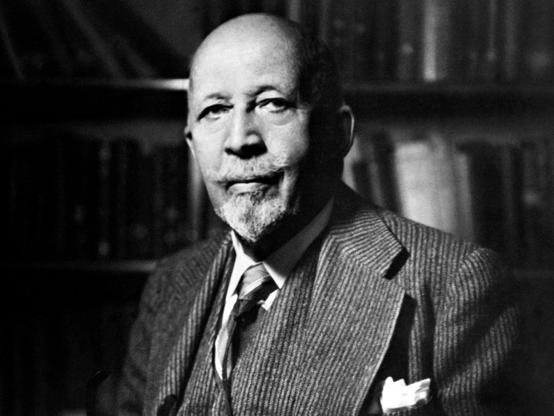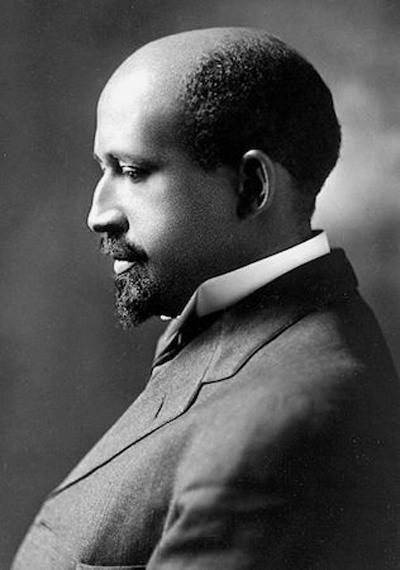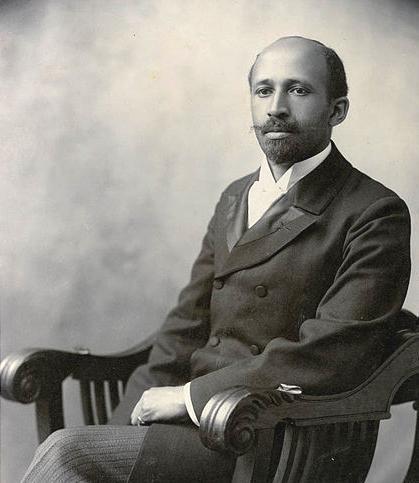The most important thing to remember is this: To be ready at any moment to give up what you are for what you might become.
-- W. E. B. Du Bois
#webdubois
W.E.B. Du Bois: challenging inequality and shaping history with intellect and courage. 📚✊
W.E.B. Du Bois
#WEBDuBois
W. E. B. Du Bois † 27. August 1963 „Es ist ein eigenartiges Gefühl, dieses doppelte Bewusstsein, dieses Gefühl, sich selbst immer mit den Augen der anderen zu betrachten, die eigene Seele am Maßstab einer Welt zu messen, die mit amüsierter Verachtung und Mitleid zusieht.“ #WEBDubois #FrantzFanon
Today in Labor History August 15, 1906: W.E.B. DuBois demanded equal citizenship rights for African-Americans during the second meeting of the Niagara Movement, saying, "We will not be satisfied to take one jot or little less than our full manhood." Founders of the movement named it for the “mighty current” of change they hoped to achieve. DuBois made his famous statement at Harper’s Ferry, sight of the failed insurrection led by John Brown, in 1859. For a wonderful speculative fiction story based on the premise that John Brown had succeeded in his raid, with the help of Harriet Tubman, read Terry Bisson’s “Fire on the Mountain” (1988).
In addition to cofounding the Niagara Movement, DuBois also cofounded the NAACP. He devoted his life to fighting racism, segregation, Jim Crow and lynchings. DuBois opposed capitalism and blamed it for much of the racism in America. He was also a prolific writer, an anti-nuclear and peace activist, and a proponent of Pan-Africanism. And he was an early proponent of Eugenics which, in the U.S., would go on to forced sterilizations of African-American women.
#workingclass #LaborHistory #naacp #niagara #webdubois #racism #panafricanism #antinuke #antiwar #BlackMastadon #anticapitalist #harpersferry #johnbrown #writer #author #books #fiction #SpeculativeFiction @bookstadon
“There is but one coward on earth, and that is the coward that dare not know.” — W. E. B. Du Bois
#quotes #webdubois #trump #maga #fascism #authoritarianism #nazism
Today in Labor History July 28, 1917: The Silent Parade took place in New York City, in protest against murders, lynchings, and other violence directed towards African Americans. Organizers set up the parade to protest the East Saint Louis race riots (May-July 1917), when whites murdered up to 200 African Americans, and caused 6,000 black residents to become homeless. While Woodrow Wilson was entering World War I to “make the world safe for democracy,” black Americans were asking when he’d do the same for them.
The Silent March was organized by a coalition of groups, led by the new NAACP. Up to 15,000 participated. Organizers wanted president Wilson to enact anti-lynching legislation. He refused. Wilson appointed numerous racists to his cabinet and was an outspoken defender of segregation on “scientific” grounds. He was also fond of telling racist jokes. As an academic, prior to his political career, he was an apologist for slavery. And he used his authority to actively prevent admitting African Americans into Princeton as students or faculty. Ironically, one of the primary organizers of the Silent March, W.E.B. DuBois, had been an enthusiastic supporter of the Woodrow Wilson presidential candidacy, calling him a “liberal Southerner,” who would deal fairly with Negros.
The East Saint Louis racist pogrom occurred during one of the largest migrations of black workers from the South to the North. Between 1910 and 1920, half a million African Americans migrated north to Chicago, Saint Louis, Detroit, Philadelphia, and other cities. In 1919, there were 38 different racist riots in the U.S., all directed against the black community. The massacre in East Saint Louis began in response to a strike by white employees of the Aluminum Ore Company, after the bosses hired black replacement workers, a common practice of the bosses to divide the working class and weaken unions. Additionally, many of the unions were overtly racist and excluded black workers, including the Aluminum Ore union. To make matters worse, employment agents were going to the South and recruiting African Americans under false pretenses, offering them stable jobs and housing when, in reality, they were being recruited to work as scabs. So, it is likely that many, if not most, of the workers didn’t even know they were being hired as scabs. Regardless, they wouldn’t have been allowed to join the union, either.
Racism by unions and white workers was not inevitable in those days, and it was certainly counterproductive to the aims of working people of all backgrounds and identities. Consider that in 1920, in rural Mingo County, West Virginia, when the coal bosses brought in African American workers as scabs, the UMWA encouraged them to join the union and the strike, and achieved solidarity between white, native-born workers, African Americans from the South, and Italian immigrants. This is portrayed in John Sayles film, Matewan. And by 1916, thanks largely to the superb organizing of Ben Fletcher, all but two of Philadelphia’s docks were controlled by the IWW, uniting a workforce that was 33% Irish, 33% Polish & Lithuanian, and 33% African American. Fletcher also traveled up and down the east coast organizing dockers across race. At that time, roughly 10% of the IWW’s 1 million members were African American.
Read my biography of Fletcher here: https://michaeldunnauthor.com/2021/05/13/ben-fletcher-and-the-iww-dockers/
#workingclass #LaborHistory #africanamerican #racism #lynching #protest #riots #naacp #union #strike #scab #IWW #benfletcher #webdubois #BlackMastadon
Celebrating Juneteenth
Photography by Carl Van Vechten in 1950s Harlem:
1) actor James Earl Jones
2) writer James Baldwin
3) Billie Holiday
4) writer WEB DuBois
#carlvanvechten #writer #writers #photographer #zoranealehurston #joycebryant #actor #africanamericanhistory #blackhistory #jamesearljones #singer #jamesbaldwin #author #billieholiday #webdubois #harlem #1950s #1950sharlem #harlemrenaissance #photography #50sstyle #style #juneteenth
#W.E.B.DuBois on #TRAITORS
Thanks for this.
RE: https://bsky.app/profile/did:plc:nvfposmpmhegtyvhbs75s3pw/post/3lrdgnmxuqc2z
"Today, I see more clearly than yesterday that the back of the problem of race and color lies a greater problem which both obscures and implements it: and that is the fact that so many civilized persons are willing to live in comfort even if the price of this is poverty, ignorance, and disease of the majority of their fellow men." ― #WEBDuBois #BlackHistory
Capitalisme et racisme. L’apport fondamental du marxisme noir
https://www.contretemps.eu/capitalisme-racisme-marxisme-noire-jeff-goodwin/
#Politique #Diaporama #Théorie #AmilcarCabral #BlackPanthers #Capitalisme #ClassesSociales #ClrJames #Esclavage #EtatsUnis #Exploitation #Fanon #MartinLutherKing #Marxisme #MouvementsNoirs #NoirsAméricains #QuestionNoire #QuestionRaciale #Race #Racisme #WebDuBois
Toni Morrison’s “Tar Baby” (1981) and W. E. B. DuBois’s “The Philadelphia Negro: A Social Study” (1899). #111Words #ToniMorrison #TarBaby #WEBDuBois #ThePhiladelphiaNegro #TheSoulsOfBlackFolk #DoubleConsciousness https://andrewjshields.blogspot.com/2025/05/toni-morrisons-tar-baby-1981-and-w-e-b.html
"The Negro is coming more and more to look upon law and justice not as protecting safeguards but as sources of humiliation and oppression. The laws are made by men who have little interest in him; they are executed by men who have absolutely no motive for treating the black people with courtesy or consideration; and finally, the accused law-breaker is tried, not by his peers but too often by men who would rather punish ten innocent Negroes than let one guilty escape." #WEBDuBois #BlackHistory
Award-winning actor Courtney B. Vance will be narrating the first ever audio edition of one of the most acclaimed literary biographies of the past 30 years, David Levering Lewis’ two volume work on the scholar, author and civil rights activist W.E.B. Du Bois. @AssociatedPress reports:
https://apnews.com/article/courtney-vance-du-bois-audio-books-pulitzer-fb4c829602c32d622d6c0e8caff8f972
#CourtneyBVance #Biography #AudioBook #DavidLeveringLewis #WEBDuBois
“Double consciousness” in Jordan Peele and Toni Morrison. #111Words #JordanPeele #GetOut #DanielKaluuya #ToniMorrison #TheBluestEye #ChollyBreedlove #WEBDuBois #TheSoulsOfBlackFolk #DoubleConsciousness #TheSunkenPlace https://andrewjshields.blogspot.com/2025/03/double-consciousness-in-jordan-peele.html
"I believe in the Prince of Peace. I believe that War is Murder. I believe that armies and navies are at bottom the tinsel and braggadocio of oppression and wrong, and I believe that the wicked conquest of weaker and darker nations by nations whiter and stronger but foreshadows the death of that strength." — #WEBDuBois #BlackHistory
ON THIS DAY IN HISTORY:
On February 23, 1868 #WEBDuBois was born. Du Bois would go on to be credited as “the most important Black protest leader in the United States during the first half of the 20th century”
Du Bois was also a founding member of the National Association for the Advancement of Colored People (NAACP).
February 19, 1919 - A Pan-African Congress was organized by W.E.B. DuBois in Paris, France, to coincide with the Versailles Peace Conference after World War I. DuBois, sociologist, historian, novelist, playwright, and cultural critic, served as special representative of the NAACP, and was assisted by Blaise Diagne, a member of the French Parliament from the West African colony of Senegal.
The Congress’s aim was to call the issue of “international protection of the natives of Africa” to the attention of the United States and the European colonial powers who were making momentous decisions on the nature of the post-war world.
DuBois was a moving spirit behind the growing struggle for self-determination among Africans, both on the continent and in the diaspora, and the Pan-African Congresses helped to bring the issues of this struggle to world attention. The Pan-African Congress was re-convened in 1921, 1923, 1927, and 1945.
Happy Black History Month from the Valley of the Dolls! #BlackHistoryMonth #gijoe #dolls #dollcollector #dollphotographer #boydolls #blackhistorymonth2025 #blackhistory #thesoulsofblackfolk #webdubois #blackauthors #blackstudies #blackstudy #civilrights #equalrights





